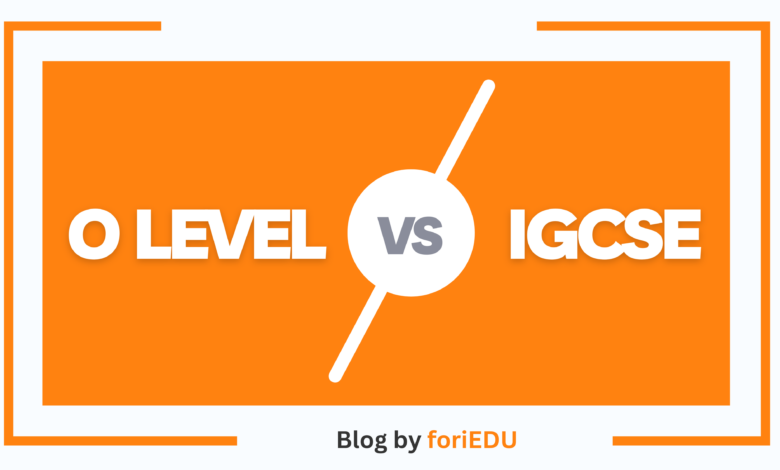What is the Difference Between IGCSE and O Level?

“Exploring the differences and similarities between IGCSE and O Level- All You Need to Know in Pakistan.”
Introduction
In the ever-expanding landscape of international education, parents and students are often faced with a perplexing array of academic programs and qualifications. Among these, the International General Certificate of Secondary Education (IGCSE) and the O Level stand out as two well-known options. However, their similarities and differences can be confusing. In this comprehensive guide, we will not only unravel the distinctions between IGCSE and O Level but also shed light on other global curriculums, such as the International Baccalaureate (IB) and American curriculums, helping you make informed choices about your educational journey.
Section 1: Understanding IGCSE and O Level
1.1. IGCSE
The International General Certificate of Secondary Education, commonly known as IGCSE, is an internationally recognized qualification designed for students aged 14 to 16. It is offered by Cambridge Assessment International Education and is known for its holistic approach to education. IGCSE covers a wide range of subjects, and students can select from an extensive menu of options.
1.2. O Level
O Level, on the other hand, is an academic qualification that was originally created by the University of Cambridge Local Examinations Syndicate. It is now offered by multiple examination boards worldwide. O Level is typically designed for students aged 14 to 16 and is renowned for its rigorous curriculum. It encompasses various subjects, but students generally take a standard set of subjects, which may include English, Mathematics, Sciences, and Humanities.

Section 2: Comparing IGCSE and O Level
2.1. Curriculum and Subjects
While both IGCSE and O Level offer a diverse selection of subjects, the key distinction lies in flexibility. IGCSE allows students to choose subjects based on their interests and future academic goals. In contrast, O Level often prescribes a set of compulsory subjects with fewer elective choices.
2.2. Assessment
IGCSE employs a variety of assessment methods, including coursework, practical assessments, and written examinations. This approach focuses on holistic learning and skill development. O Level, conversely, relies predominantly on written examinations, emphasizing academic knowledge and theory.
2.3. Grading
IGCSE utilizes a grading system that ranges from A* to G, with A* signifying the highest level of achievement. O Level typically uses a numerical grading system, with 1 being the highest and 9 the lowest or from grade A* to E.
2.4. Recognition
Both IGCSE and O Level are globally recognized qualifications that can open doors to higher education and career opportunities. The choice between the two often depends on regional preferences, the curriculum offered by schools, and individual student goals.

Section 3: Beyond IGCSE and O Level: Exploring Other Global Curriculums
3.1. International Baccalaureate (IB)
The International Baccalaureate (IB) program is a globally respected curriculum that offers a holistic and well-rounded education. It is designed for students aged 16 to 19 and is known for its emphasis on critical thinking, research, and community service. The IB program includes the IB Middle Years Program (MYP), the IB Diploma Program (DP), and the IB Career-related Program (CP), catering to a wide range of academic interests.
3.2. American Curriculums
The American education system encompasses various curriculums, such as Advanced Placement (AP) and the High School Diploma. AP courses are designed for high school students and offer college-level content. Students can earn college credits by performing well in AP exams. The High School Diploma is the standard American qualification for high school graduates, and it allows students to enter American universities.
Section 4: Choosing the Right Curriculum for Your Educational Journey
4.1. Consider Your Goals
The choice between IGCSE, O Level, IB, or American curriculums should align with your academic and career goals. Consider what you aspire to study in college or university and which curriculum complements those aspirations.
4.2. Regional Relevance
The acceptance and recognition of specific qualifications may vary by region. Research the requirements of educational institutions and employers in your area to ensure that your chosen curriculum is in line with their expectations.
4.3. Learning Style
Reflect on your learning style and preferences. Do you thrive in a diverse and flexible learning environment, or do you prefer a more structured and exam-oriented approach? Your learning style can help guide your curriculum choice.
4.4. School Availability
In some cases, the choice of curriculum may be influenced by the schools available in your area. Consider the schools and their curriculum offerings when making your decision.
However, you can also consider hiring private tutors to improve your learning experience.
Conclusion
In the ever-evolving world of international education, students and parents are presented with a myriad of choices. IGCSE and O Level, while similar in some aspects, have their own unique features that cater to different academic needs and aspirations. Additionally, global curriculums like IB and American systems offer diverse approaches to learning and preparation for higher education.
The choice of curriculum should align with your individual goals, learning style, and regional context. Ultimately, the key to success in any curriculum is dedication, hard work, and a genuine passion for learning. Whether you choose IGCSE, O Level, IB, or an American curriculum, your educational journey is a significant stepping stone towards a bright future.



